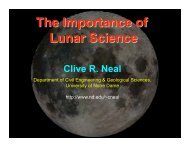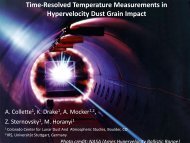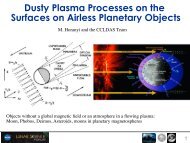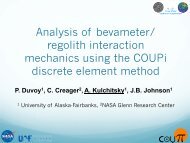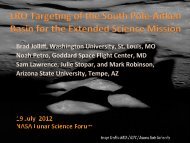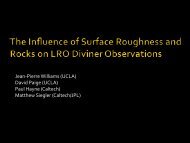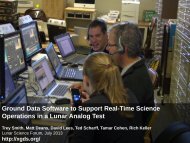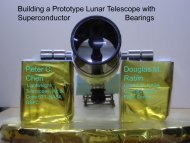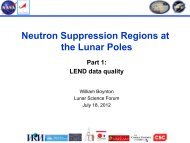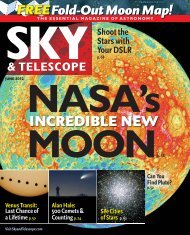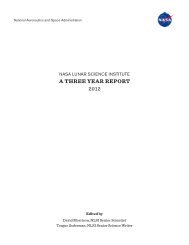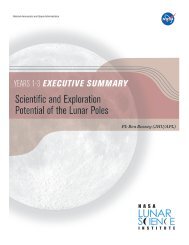From Stardust to Planetesimals: Contributed Papers - NASA Lunar ...
From Stardust to Planetesimals: Contributed Papers - NASA Lunar ...
From Stardust to Planetesimals: Contributed Papers - NASA Lunar ...
Create successful ePaper yourself
Turn your PDF publications into a flip-book with our unique Google optimized e-Paper software.
1995, we observed 6 stars from the WW list. Weather conditions were very good,with little or no problems from cirrus. To calibrate the data, we observed knownspectral standards and applied additional corrections <strong>to</strong> correct for the atmospherictransmission (such as the 10 ym ozone feature). Overall the stability from one night<strong>to</strong> the next was excellent. Our general procedure is <strong>to</strong> observe one grating setting onone night. The setting then is shifted slightly (<strong>to</strong> fill in gaps caused by bad pixels) andthe observations repeated the second night. This allows us <strong>to</strong> have two independentspectra that can then be interweaved <strong>to</strong> provide Nyquist sampling.5. DISCUSSIONWe observed a PsA, P Cas, HD 188037, HD 14432, HD 142666, and 51 Oph. Botha PsA and /3 Cas show no evidence of silicate features but a hint of the onset of athermal dust continuum at 12 Mm. HD 188037 has been reported <strong>to</strong> have an M starcompanion, which would explain the observed "astronomical" silicate feature we see.HD 144432 has a feature reminiscent of that seen <strong>to</strong>wards GW Ori (a binary youngstellar object thought <strong>to</strong> have disk). HD 142666 has a broad silicate feature, similar<strong>to</strong> that that Sylvester et al. (1995) report for HD 98800. Our data show no examplesof PAH-like emission features, though Sylvester et al. report PAH features for threeother sources (HD 169142, HD135344, and HD 141596).51 Oph, thought <strong>to</strong> be a Be star with a dust disk, was reported by Fajardo-Acostaet al. (1993) <strong>to</strong> have silicate emission features similar <strong>to</strong> 0 Pic and comet P/Halley.They found that the dust around 51 Oph was warmer than P Pic and argued thatthe grains would be larger than the grains around 6 Pic. Sylvester et al. (1995) alsoobserved 51 Oph, but make no comment about the emission other than <strong>to</strong> note it issilicate emission. Our own data has been carefully reduced, and a 550 K blackbodyremoved from the continuum. The feature appears <strong>to</strong> have an unusual broad shoulderin the emission beyond 10 tcm (Figure 1). One of the glass-rich IDPs discussed byBradley et al. (1992) is similar <strong>to</strong> the 51 Oph spectra. We applied similar continuumremoval <strong>to</strong> the HD 142666 and HD 144432 spectra and find prominent bumps in bothspectra at 11 µm. Comparison of the 51 Oph, HD 142666, and HD 144432 spectrawith examples of cometary spectra (Hanner et al. 1993) shows that the P/Halley andP/Bradfield-87 spectra are very simlar. A detailed analysis of the spectral featuresfor each star awaits full models, but it would appear that we can use the comets andIDPs as analogs for the average silicate dust found in some of these systems.The results <strong>to</strong> date suggest that many of the a Pic-like stars have dust that hasundergone processing similar <strong>to</strong> that seen in cometary dust.Acknowledgements. HMB wishes <strong>to</strong> acknowledge the support of the <strong>NASA</strong>Origins of the Solar System Program (NAGW-4097) and the Carnegie Institution ofWashing<strong>to</strong>n.ReferencesAumann, H. 1985, Pub. A. S. P., 97, 88515



